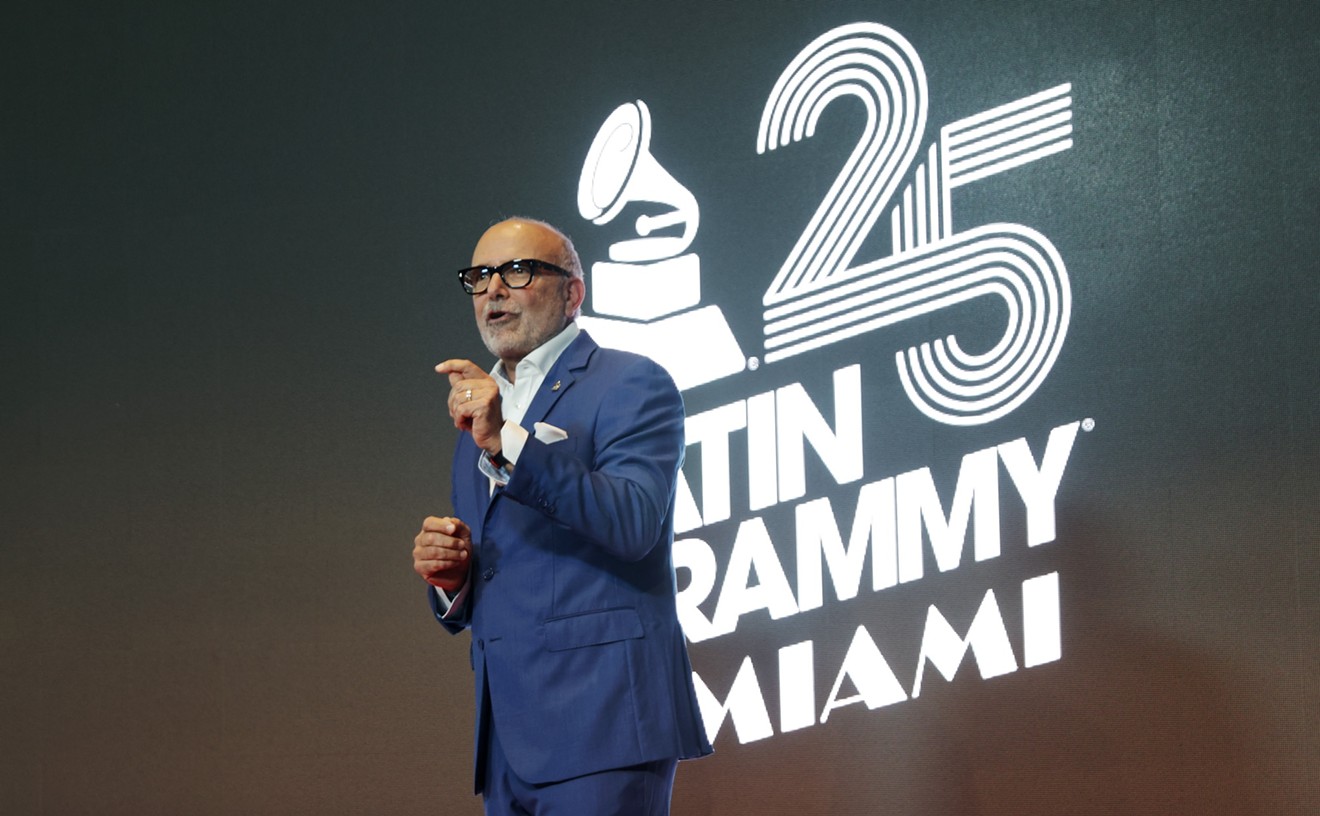A few moments later, in between bites of a sirloin burger ("Very healthy!" he quips), he hesitantly admits that boredom is a state in which he often finds himself. Lucky for him his repeated attempts to alleviate that condition have carried him far in life. Indifference to the study of law is why he neglected to follow the family path and become an attorney. Impatience with the simplistic sounds of conventional Cuban music at the time (after being exposed to the wonders of big-band jazz during a military-school stint in Georgia) motivated him to leave his Cuban homeland and settle in New York City. And inquietude with the lucrative yet ultimately unchallenging life of composing and conducting advertising jingles thrust him back into the world of Afro-Cuban jazz after an extended hiatus. O'Farrill, at age 78, is at last beginning to enjoy the international recognition he deserves, being rediscovered in the recent worldwide embrace of all things Latin.
But what seems a sudden romance with Latin music is nothing new. Those knowledgeable about the subject are well aware the genre encompasses more than just salsa, that salsa owes its very existence to styles of the past. And that's where O'Farrill, a Cuban of Irish descent, comes in. A trumpet player, he made his name writing and arranging music in the late Forties and early Fifties, a particularly productive period when Cuban sounds began to pervade the compositions of several jazzsters. Movie musicals featured exotic themes and starred cheesy actor/singers Carmen Miranda and Desi Arnaz. Orchestras led by foreigners such as Xavier Cugat and the transplanted Machito were all the rage. Anglo band leaders such as Stan Kenton quickly jumped on the bandwagon. Latin rhythm sections melded with jazz instrumentation and came to be known as Afro-Cuban jazz or Cubop, signifying a blend of bebop and Cuban rhythms.
In 1948, freshly relocated to New York, O'Farrill abandoned the trumpet ("I didn't want to threaten Dizzy Gillespie!" he laughs) and concentrated on writing and arranging. In the Brill Building office of Gil Fuller, for whom he worked as a ghost arranger, he had a fortuitous meeting with clarinetist Stan Hasselgard, a protégé of Benny Goodman. That landed him an audience with the popular band leader, who, according to O'Farrill, skeptically remarked: "Latin people aren't supposed to write jazz!" When Goodman realized how well this particular Latin wrote, he snapped him up. "It was my lucky break," notes O'Farrill, who adds that the good fortune was supplemented by the fact that he was "slightly hungry."
O'Farrill began working with Goodman's band, creating many compositions, including "Undercurrent Blues," which became a hit. A few years later, he hooked up with the acclaimed Machito and his Afro-Cubans, catching the ear of renowned jazz producer and promoter Norman Granz of Verve Records. Granz encouraged the composer to write a "more serious" work. The result was the striking multipart Afro-Cuban Jazz Suite, recorded by Machito's orchestra with all-star additions of Charlie Parker, Flip Phillips, and Buddy Rich. With its dissonant, brassy, almost hair-raising intro and refrain, the complex and urbane piece set the standard for Afro-Cuban jazz tunes created thereafter.
In his classic text The Story of Jazz, Marshall Stearns observes that Latin jazz has the ability to "swing remorselessly" and O'Farrill's works, which exhibit similarities to his self-described often-antsy state, are ample testimony to that claim. Created in this country during a frenetic postwar period that saw the growth of the baffling-to-some bebop movement, his music is brash, brazen, kinetic, undeniably Cuban in its sultry rhythm, yet overwhelmingly American in its freshness and audacity. Although he studied with Cuban composer Felix Guerrero, O'Farrill knew he was destined to write in the jazz idiom: "I found it so dynamic," he says, recalling jazz's allure. "It used richer harmonies and instrumentation. It was such an exciting music."
Lavish harmonies and intricate instrumentation soon became an O'Farrill trademark as he continued to weave together exhilarating sounds for Stan Kenton's band and Machito's orchestra, including the rollicking work Manteca, written by trumpeter Gillespie, celebrated Cuban percussionist Chano Pozo, and arranger Gil Fuller. O'Farrill also busied himself with his own ensemble, recording several albums for Granz's Clef and Norgran labels in the early Fifties. But by the mid- to late Fifties, the appeal of Afro-Cuban jazz began to wane among musicians and listeners. O'Farrill returned to Cuba for a few years and then, besieged by personal problems stemming from a messy divorce, retreated to Mexico in 1958. There he wed his second wife, Lupe, to whom he is still married; formed and conducted his own band, which toured frequently; and recorded several albums. By 1965, his affair with the land south of the border was over, and he yearned to return to the United States.
Lured stateside by vocalist Andy Russell, O'Farrill played Las Vegas during the vibrant Rat Pack era, then returned to New York to join the Count Basie Orchestra. It was the early Seventies -- beyond the twilight of big band -- and rock and roll was dominant. Out of necessity O'Farrill took work creating music for television commercials. "The money was great, and I fell in love with it," he recalls. "Sometimes you could sneak some good music in there." The outcry from fellow musicians, who preferred starving over selling out may have been loud, but ironically those ditties for McDonald's, Pepsi-Cola, and Kent cigarettes probably reached a wider audience than O'Farrill's tunes ever had before, or ever would again. Not that he had given up on the jazz world: All the while he continued writing. In the mid-Seventies he did some arranging for Argentine saxophonist Gato Barbieri. In 1975 he worked with old friends Gillespie and Machito on Afro-Cuban Jazz Moods, a languid trio of pieces evoking various frames of mind. But it was not until 1979, when noted Cuban exile movie director Jorge Ulla (Nobody Listened) commissioned him to score his debut feature, Guaguasí, that he would produce something entirely his own again. "I enticed him," Ulla says about cajoling O'Farrill, whom he affectionately refers to as "the old man," away from the world of advertising. "It was a combination of friendship and the temptation of coming back to music. Then he sort of disappeared again."
O'Farrill's self-imposed obscurity was punctuated with arrangements for Ringo Starr and David Bowie. But many years would elapse before he re-entered the recording studio and emerged with an album of original tunes. That work, Pure Emotion, released in 1995, subsequently was nominated for a Grammy Award. This year Ulla, O'Farrill's pianist/band leader son Arturo, and distinguished producer Todd Barkan got him and a big band in the studio for more. The result: Heart of a Legend, an unbridled exploration of some his recent compositions and a look at several songs of the past. Cha-cha-cha, mambo, the blues, a trumpet fantasy dedicated to Wynton Marsalis, rearrangements from Guaguasí, and an abbreviated version of Manteca are included on the CD, as is a stunning cast of musical luminaries: vocalist Freddy Cole; bassist Israel "Cachao" Lopez; brass men Alfredo "Chocolate" Armenteros, Paquito D'Rivera, Arturo Sandoval, Gato Barbieri, and Juan Pablo Torres; and percussionists Carlos "Patato" Valdes and Candido Camero among them. The O'Farrill album, released on the Milestone label, soon will be visual as well as aural. Inspired by the "hot" studio sessions, Ulla filmed them for a documentary in the works about the musician, slated to be released next winter. "It's very rewarding to do something in the art world, in the entertainment business, that is rewarding not only to you, but also in the sense that you are setting the record straight," Ulla says. "In a way it's some sort of cultural rescue."
And, marvels Ulla, "it's a rebirth for the old man!" It seems O'Farrill has been revitalized in more than just the musical sense. During the studio sessions a couple of months ago, he had been rather sickly and frail. Now, to promote Heart of a Legend's release, the composer/arranger seems unstoppable, embarking on an international publicity tour that includes Miami, Boston, Los Angeles, even Japan. In the future O'Farrill hopes to stay vital and visible, continuing with his son to lead his big band during their regular Sunday stint at New York City jazz mecca Birdland, and thinking about another album. For the moment the overwhelming outpouring of affection and regard means the world finally has caught up with him, but if the dynamic O'Farrill has his way, it won't be for long.










